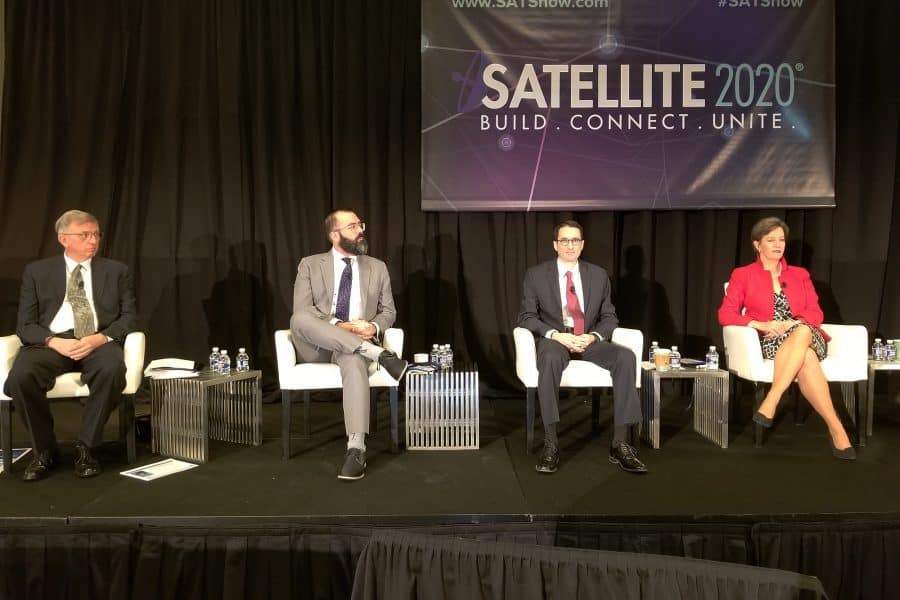DOD Seeks New Satellite Communications Prototypes

The Defense Department wants satellite operators, including smallsat start-ups and other innovative companies, to offer visions of a new seamless communications system for the U.S. military.
A contract solicitation issued on March 3 launched a four-phase prototyping effort that will lead to “a new architecture that looks nothing like the current one” for command, control, and communications, said Doug Schroeder, oversight executive of DOD’s Joint Capability Technology Demonstration. The idea is that, eventually, the new architecture would allow “any user using any terminal anywhere to seamlessly connect to any other user using any other terminal” anywhere, he told an audience of industry executives during a panel discussion at Satellite 2020 in Washington.
The solicitation, in the form of a Broad Agency Announcement, says the new system “will enable the DOD to reliably communicate with all its tactical and strategic assets.” It adds that the goal of the prototyping is to transition the winning technologies “into programs of record as a component of the department’s next-generation communications system, which is currently under development.”Though many of the details are classified, the next-generation system will be a radical departure from current models, said fellow panelist Deputy Assistant Secretary of Defense for Space Policy Stephen Kitay. It will employ many more satellites to ensure redundancy and have the ability to maintain communications even in the face of anti-satellite weapons that are increasingly being deployed by U.S. adversaries, he said.
“It is a fundamentally different architecture than we have today,” Kitay said. “It is based on a proliferated low earth orbit constellation that goes from [a legacy system consisting of a few] big fat juicy targets to a much more distributed system, … much more resilient.”
The BAA comes as the military faces what some are calling a crisis in military satellite communications as the DOD’s legacy Ultra High Frequency, or UHF satellites reach the end of their useful lives, and their replacement—the Mobile User Objective System (MUOS) satellite constellation—is lagging.
The BAA envisages a four-phase process, a white paper and pitch day, followed by a system design phase, a system development phase, and finally a system demonstration and prototyping phase. The process, which could take up to four years, will be done under Other Transaction Authority—a form of acquisition that makes it quicker and easier to ink deals with companies, like startups, that aren’t traditional defense contractors.
There is no dollar amount given in the BAA. Instead, white paper submissions are expected to include a cost to complete the development phase.
“Our technical leadership … are relying heavily on industry to transform our C3 networks,” said Schroeder. But once it gets beyond the prototyping stage, the reboot will be transferred as a program of record to the new Space Development Agency, he said.
The solicitation invites submissions in three capability areas:
“Protected radio frequency (RF) Beyond Line-of-Sight (BLOS) communicationsMulti-user high bandwidth laser communicationsCommunications with submerged assets, like submarines.
“These are three critical communication capabilities that the warfighter needs,” Joanne Sears told Air Force Magazine. Sears, a former Defense Department official now a partner with Velocity Government Relations, moderated the panel where Schroeder unveiled the BAA.
She noted that there was “a very tight window” for white paper submissions, which have to be sent in by March 31. “They seem to want to move fast, which suggests either the need is very urgent or they already have certain concepts or companies in mind.”
Sears said the BAA seemed very open as to the kind of solutions it was seeking, “It could be a new way to use existing constellations,” she said, “They are asking people to be very flexible and creative.”
Photo: From left to right, Douglas Schroeder, oversight executive in the Office of the Undersecretary of Defense for Research and Engineering; Joshua Huminski, director of the National Security Space Program at the Center for the Study of the Presidency and Congress; Deputy Assistant Secretary of Defense for Space Policy Stephen Kitay; and Rebecca Cowen-Hirsch, senior vice president for government policy and strategy at Inmarsat Government, appear on a panel on March 9, 2020, during the Satellite 2020 conference in Washington. Photo by Shaun Waterman.
Link: https://www.airforcemag.com/dod-seeks-new-satellite-communications-prototypes/











